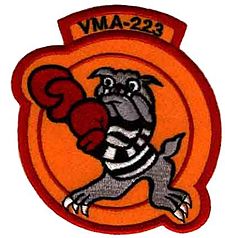
Marine Fighter Attack Squadron 211 (VMFA-211) is a United States Marine Corps fighter attack squadron, currently consisting of F-35B Lightning II stealth STOVL strike fighter jets. Known as the "Wake Island Avengers" and the "Bastion Defenders", the squadron is based at Marine Corps Air Station Yuma, Arizona and falls under the command of Marine Aircraft Group 13 (MAG-13) and the 3rd Marine Aircraft Wing.
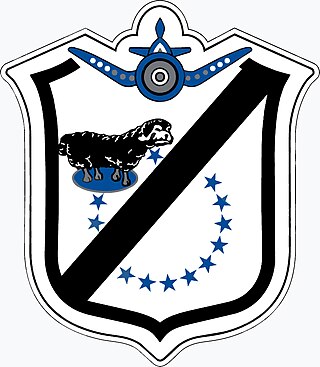
Marine Fighter Attack Squadron 214 (VMFA-214) is a United States Marine Corps fighter attack squadron flying the Lockheed Martin F-35B Lighting II. The squadron's home field is Marine Corps Air Station Yuma, Arizona, and it is assigned to Marine Aircraft Group 13 (MAG-13) of the 3rd Marine Aircraft Wing.

Marine Fighter Attack Squadron 311 (VMFA-311) is a United States Marine Corps fighter attack squadron consisting of F-35C Lightning II. Known as the "Tomcats", the squadron is based at Marine Corps Air Station Miramar, California and falls under the command of Marine Aircraft Group 11 (MAG-11) and the 3rd Marine Aircraft Wing.

Marine Fighter Attack Training Squadron 502 (VMFAT-502) is a United States Marine Corps fighter attack training squadron flying the Lockheed Martin F-35 Lightning II. Known as the "Flying Nightmares", the squadron maintains the history of Marine Attack Squadron 513 (VMA-513) which dates back to World War II and was decommissioned on 12 July 2013. The squadron is based at Marine Corps Air Station Miramar and falls under the command of Marine Aircraft Group 11 and the 3rd Marine Aircraft Wing
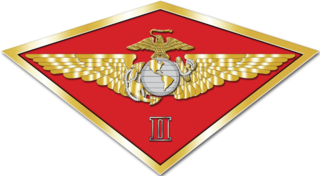
The 2nd Marine Aircraft Wing is the major east coast aviation unit of the United States Marine Corps and is headquartered in Marine Corps Air Station Cherry Point, North Carolina. The Wing provides the aviation combat element for the II Marine Expeditionary Force.

Marine Medium Tiltrotor Squadron 264 (VMM-264) was a United States Marine Corps tiltrotor squadron consisting of MV-22 Osprey transport aircraft. The squadron, known as the "Black Knights", was based at Marine Corps Air Station New River, North Carolina, and normally fell under the command of Marine Aircraft Group 26 (MAG-26) and the 2nd Marine Aircraft Wing. They were the last east coast CH-46 Sea Knight squadron to transition to the Osprey. VMM-264 was decommissioned on June 24, 2020.

Marine Medium Tiltrotor Squadron 365 (VMM-365) is a United States Marine Corps tiltrotor squadron consisting of MV-22B Osprey transport aircraft. The squadron, known as the "Blue Knights", is based at Marine Corps Air Station New River, North Carolina and falls under the command of Marine Aircraft Group 26 (MAG-26) and the 2nd Marine Aircraft Wing.

Marine Attack Squadron 231 (VMA-231) is a United States Marine Corps fixed wing attack squadron that consists of AV-8B Harrier (V/STOL) jets. The squadron, known as the "Ace of Spades", is based at Marine Corps Air Station Cherry Point, North Carolina and fall under the command of Marine Aircraft Group 14 (MAG-14) and the 2nd Marine Aircraft Wing.

Marine Fighter Attack Squadron 542 (VMFA-542) is a United States Marine Corps Aviation fighter attack squadron flying the F-35B Lightning II. VMFA-542 is based at Marine Corps Air Station Cherry Point, North Carolina and falls under the command of Marine Aircraft Group 14 (MAG-14) and the 2nd Marine Aircraft Wing.

Marine All Weather Fighter Attack Squadron 224 is a United States Marine Corps F/A-18 Hornet squadron. Also known as the "Fighting Bengals", the squadron is based at Marine Corps Air Station Beaufort, South Carolina and falls under the command of Marine Aircraft Group 31 (MAG-31) and the 2nd Marine Aircraft Wing. The Bengals are the only Marine F/A-18D Hornet Squadron currently operating out of MCAS Beaufort.
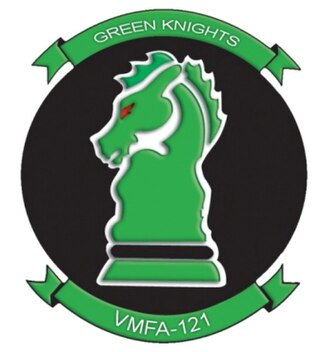
Marine Fighter Attack Squadron 121 (VMFA-121), also known as the "Green Knights", is a United States Marine Corps aircraft squadron operating the F-35B Lightning II. The squadron is based at Marine Corps Air Station Iwakuni, Japan and falls under the command of Marine Aircraft Group 12 (MAG-12) and the 1st Marine Aircraft Wing. Their tail code is VK and their radio call sign is "Combat".

Marine Aircraft Group 13 is a United States Marine Corps aviation unit based at Marine Corps Air Station Yuma that is currently composed of one McDonnell Douglas AV-8B Harrier II squadron, three Lockheed Martin F-35B Lightning II squadrons, an unmanned aerial vehicle squadron, a maintenance and logistics squadron, and a wing support squadron. The group falls under the command of the 3rd Marine Aircraft Wing and the I Marine Expeditionary Force.
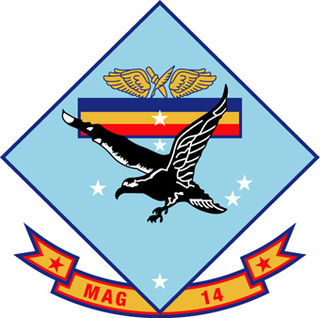
Marine Aircraft Group 14 (MAG-14) is a United States Marine Corps aviation unit based at Marine Corps Air Station Cherry Point, North Carolina that is currently composed of two AV-8B Harrier squadrons, one F-35B squadron, one UAV training squadron, one KC-130 squadron, and an aviation logistics squadron.

Marine Fighter Attack Squadron 533 (VMFA-533) is a United States Marine Corps F-35B squadron. Also known as the "Hawks", the squadron is based at Marine Corps Air Station Beaufort, South Carolina and falls under the command of Marine Aircraft Group 31 (MAG-31) and the 2nd Marine Aircraft Wing.

VMFA(AW)-332 Marine All Weather Fighter Attack Squadron 332 was a United States Marine Corps F/A-18 Hornet squadron. Also known as the "Moonlighters", the squadron was based at Marine Corps Air Station Beaufort, South Carolina as part of Marine Aircraft Group 31 (MAG-31), 2nd Marine Aircraft Wing. The squadron flew its last flight in the F/A-18 Hornet on March 30, 2007. At the time of their deactivation, they held the longest streak of mishap-free flight hours for a tactical jet squadron at 109,000 hours.

Marine Aviation Logistics Squadron 13 (MALS-13) is an aviation logistics support unit of the United States Marine Corps. Known as the "Black Widows", it is currently based at Marine Corps Air Station Yuma, as part of Marine Aircraft Group 13 and the 3rd Marine Aircraft Wing.
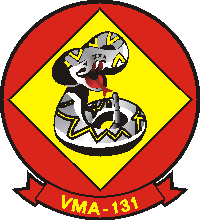
Marine Attack Squadron 131 (VMA-131) was an A-4 Skyhawk attack squadron in the United States Marine Corps. The squadron, also known as the “Diamondbacks”, were part of the Marine Forces Reserve and were based at Naval Air Station New York, Brooklyn, New York from 1960 through 1970 and NASJRB Willow Grove from 1971 until their deactivation in 1998.

Marine Attack Squadron 331 (VMA-331) was an attack squadron in the United States Marine Corps. The squadron, also known as the “Doodlebugs” and “Bumblebees,” was part of Marine Aircraft Group 31, 2nd Marine Aircraft Wing and was based out of Marine Corps Air Station Beaufort, South Carolina. The squadron fought in World War II and Operation Desert Storm. It was decommissioned as part of the post Cold War drawdown of the US Military on October 1, 1992.

The McDonnell DouglasAV-8B Harrier II is a single-engine ground-attack aircraft that constitutes the second generation of the Harrier family, capable of vertical or short takeoff and landing (V/STOL). The aircraft is primarily employed on light attack or multi-role missions, ranging from close air support of ground troops to armed reconnaissance. The AV-8B is used by the United States Marine Corps (USMC), the Spanish Navy, and the Italian Navy. A variant of the AV-8B, the British Aerospace Harrier II, was developed for the British military, while another, the TAV-8B, is a dedicated two-seat trainer.

Jon M. Davis is a retired United States Marine Corps lieutenant general. His last assignment in the Marine Corps was as the Deputy Commandant for Aviation.
